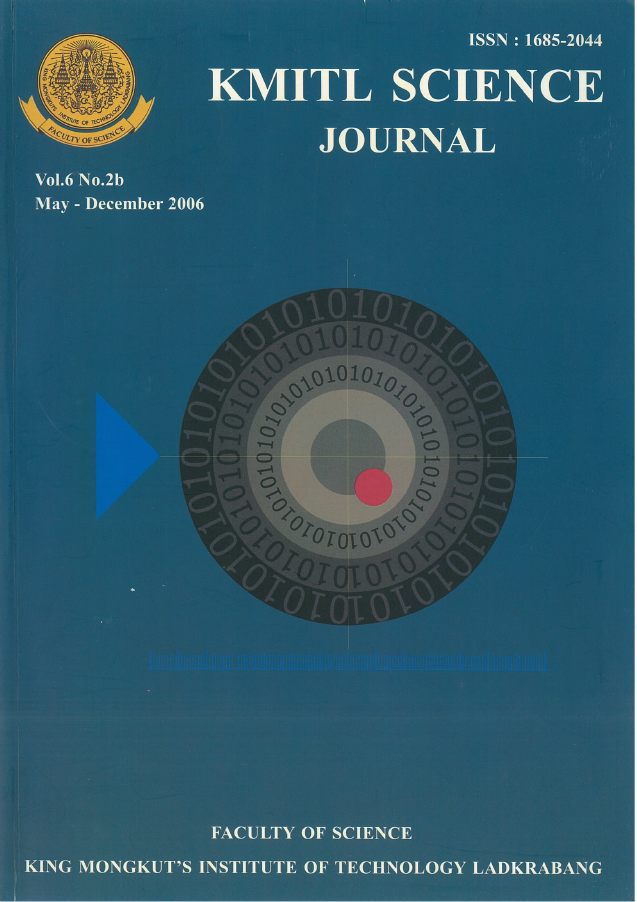Glucosamine Extraction from Silkworm Molt
Main Article Content
Abstract
The objective of this study was to find the efficient process of glucosamine extraction from hybrid silkworm molt. In principle, the main extractive process consisted of two steps. In the first step, silkworm molt was extracted to chitosan by deproteinisation, demineralisation, and deacetylation of chitin.In the second step, chitosan was depolymerized to glucosamine hydrochloride by hydrolysis reaction with variation of acid and base concentration, temperature and reaction time. From the experiment of the first step, the suitable KOH concentration in depreteinisation was 4.0% w/v at 80.0 °C for 1.5 hours while 1.0 M of HCl was the appropriate concentration in demineralisation at 45.0 °C and 1.5 hours. The appropriate deacetylation of chitin was to use 40% w/v KOH at 110.0 °C and 4.0 hours. The purity of glucosamine hydrochloride in depolymerisation was measured by HPLC (High Performance Liquid Chromatography) and compared the method of hydrolysis reaction to produce glucosamine by using HCl. cellulose TV enzyme and HCl followed by cellulose TV. enzyme as catalysts. The appropriate HCl concentration to hydrolyse chitosan was 10.7 M at 80.0 °C and 7.0 hours to reach 27.0% by crystal weight purity of glucosamine while the suitable ratio by weight in gram of cellulose TV. enzyme to chitosan was 2:1 at 37.0 °C, pH 4.0 and 12.0 hours to obtain 76.2% by crystal weight purity of glucosamine. The hydrolization of chitosan by cellulose TV. enzyme after HCl hydrolysis at the suitable condition was the most efficient to produce glucosamine hydrochloride by using the ratio by weight in gram of cellulose TV. enzyme to chitosan at 2:1, 37.0 °C, pH 4.0 and 2.0 hours (total hydrolysis time was 9.0 hours) to reach 76.0% by crystal weight purity of glucosamine.
Keywords: Chitosan, Glucosamine of Glucosamine Hydrochloride, Hydrolysis
Corresponding author: E-mail: naraporn.han@kmutt.ac.th
Article Details
Copyright Transfer Statement
The copyright of this article is transferred to Current Applied Science and Technology journal with effect if and when the article is accepted for publication. The copyright transfer covers the exclusive right to reproduce and distribute the article, including reprints, translations, photographic reproductions, electronic form (offline, online) or any other reproductions of similar nature.
The author warrants that this contribution is original and that he/she has full power to make this grant. The author signs for and accepts responsibility for releasing this material on behalf of any and all co-authors.
Here is the link for download: Copyright transfer form.pdf
References
[2] McCarty, M.F. 1994 The neglet of glucosamine as a treatment for osteoarthritis a personal perspective, Medical Hypotheses, 42(5), 323-327.
[3] Giordano, N., Nardi, P., Sensi, M., Palumbo, F., Battisti, E., Gonnelli, S., Franci, B., Campagna, M.S., Gennari, C. 1996 The efficiency and safety of glucosamine sulfate in the treatment of gonarthritis, Clinica Therpeutica, 147(3), 99-105.
[4] Hammock, B.D. 2001 Insect factory, present status and possible development. Proceeding of the first International Conference of European Chitin Society, France, pp. 101-104.
[5] Penchouk., T. 1983 Insect Physiology. Bangkok, Department of entomology, Kasetsart University.
[6] Barker, S.A., Foster, A.B., Stacey, M., Webber, J.M. 1958 Hydrolysis of chitin and chitosan by HCl, J. Chem. Soc, 2218.
[7] Break, S., Anthonsen, T., Standford P. 1989 Chitin and Chitosan, London-New York Elsevier Appl. Sci.
[8] Robert, G.A.F. 1992 Chitin Chemistry. London, Macmillan Press Ltd.


